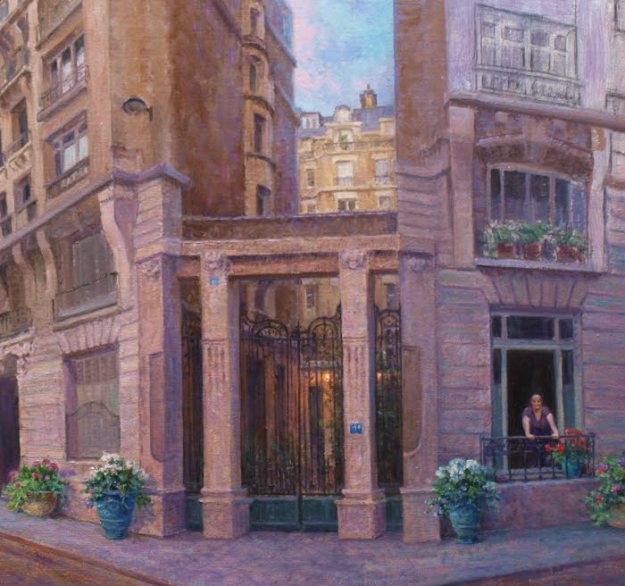In this segment on my oil painting demo of Paris France, “serious” work begins with refining the focal area, starting with the shadowed side of the middle building. This was done so the values of the adjacent sky and distant building in the sunlight could be judged against it. Cool reflected sky colors were added into the shadowed side which helps it recede.
Work continued downward painting in the section between the two main buildings and into the courtyard area. Once dry the wrought iron gate was painted over it keeping the detail to a minimum with just enough to express its character.
COMPOSITION REFINEMENT
Two important compositional changes in refining the focal area were also made from the original drawing. First, the woman pedestrian in the foreground returned to her apartment. She forgot something so she had to go. Her purpose was to act as a jump point for the eye to travel through the scene. However, a simpler approach of adding more potted flowers would serve the same purpose. Additionally, more emphasis is shifted to my client’s wife in the window. Blue colored French style planters brings balance to each side of the entry way. Plus it allowed more of my clients favorite colors to be added into the scene.
A slight fractional increase in the size of my clients wife in the window was the second compositional change along with changing her outfit’s color to purple, her favorite color. Adding a spot of red in the potted Geraniums next to her also prompts the eye to move to that area.
That warm touch of red adds a bit of color contrast to an area composed of cool colors. The reason for all these tones of violet, blue and even cool greens in this side of the building is that it’s at a different angle to the light. Therefore, being in shadow, it receives more reflected light from the sky.
PROGRESS
The next phase of work begins with painting in the light side of the middle building. Once this is dry, perspective angles will be checked and redrawn if necessary. More refinements and details will be added. Don’t misunderstand the term detail. This can also mean simplify and with so much architectural motifs on these buildings they need to be played down and that can be even more difficult than rendering them in tight detail.
Again the painting is not about the architecture, but my client’s wife and the time they shared in Paris. Everything in the painting has to support this concept. Additionally per their request the painting needs to be kept more impressionistic. In the end some elements will likely be softened. Even with buildings you can’t have all hard edges!
Hope you’ll come back to see more.






















































